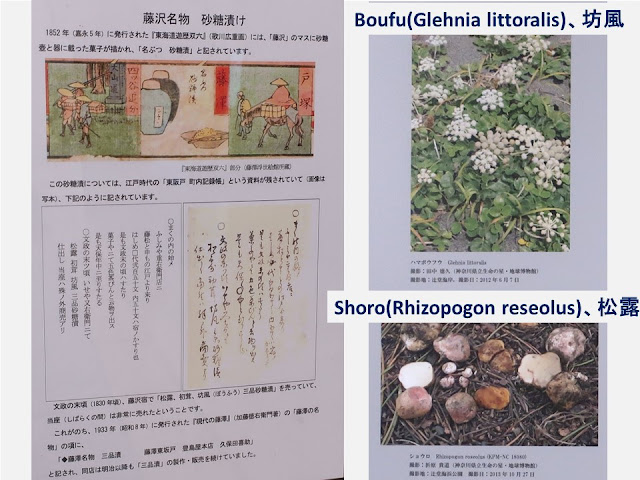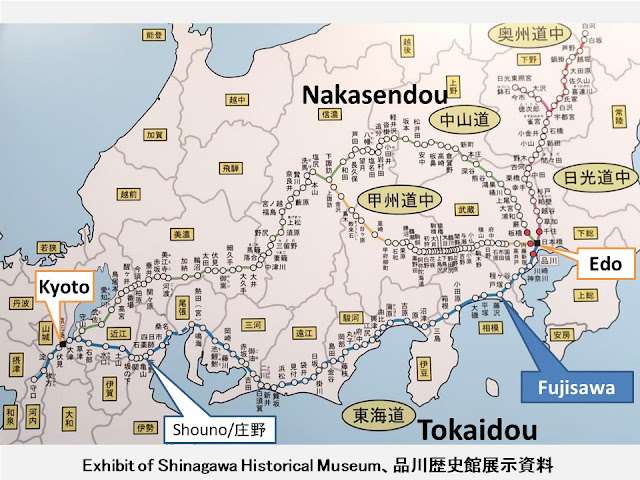Fujisawa was a post town on Tokaidou highway (Kaido (Highway) and Shukuba (Post town) ) in the Edo period, which is
located around 50km south-west of Tokyo. It was an important point because the
roads to Ooyama, Enoshima, Atsugi and Hachiouji gathered. It has a head temple “Yugyou-ji”
which is famous for Odori(dancing)-nenbutsu(chanting).
This is a tourist information and community
center, but its local history exhibition room shows
us the history of Fujisawa post town.
神奈川県にある東海道藤沢宿は、大山、江ノ島、厚木、八王子への道が集まる交通の要衝になっています。踊り念仏の総本山遊行寺もあります。交流館は、観光案内所兼公民館的な施設ですが、郷土資料展示室では藤沢宿の歴史がしっかり紹介されています。
There are bulletin boards beside the building.
施設外観。高札場も作られています。
Model of Fujisawa post town: we can hear seven folk tales (in Japanese). There is a doll who was depicted in the Ukiyo-e printing of Toyokuni Utagawa (upper-left), she is attractive.
藤沢宿の模型。江ノ島詣でや民話など六つの話を聴けるようになっています。歌川豊国が藤沢宿の浮世絵で描いた色っぽい女性を人形にして添えてあります(左上)。
The population of Fujisawa post town was 4,000 in 1843, so it was a big one. It says “The specialties were seafoods (turban shell, abalone and dried baby sardines) and Benkei mochi cake.”
藤沢宿は、人口4,000人(1843年)の大きな宿場です。名物は、さざえ、鮑、しらす干し(ひしこまなす)の海産物と弁慶餅と書かれています。
This footwear shop is designated as a national culture asset. The craftsman is cool.
国登録有形文化財になっている旧石曽根商店が写真と製品(履き物)で説明されています。職人さんの姿が粋ですね。
There are panels in the room next to the exhibition room. We can know the history and topics of Fujisawa here.
展示室の隣の多目的ホールの壁にも藤沢宿の歴史や逸話が掲示されています。
Toukaidou Sugoroku which is similar to snakes and ladders by Hiroshige Utagawa (1852): it is named “traveling around”. It is written that the specialty of Fujisawa is a candied food.
歌川広重の東海道遊歴双六(1852年):「遊歴」(諸国漫遊)と名付けられた、楽しそうな双六です。藤沢名物は「砂糖漬」と書かれています。
The three candied foods which were Shoro, Boufu and mushrooms became popular around 1830. Those were sold even in the Meiji period (1868-1912).
「松露、初茸、坊風三品砂糖漬」が1830年頃売れて、明治に入っても三品漬として売られていたとのこと。丁寧な説明です。
H. Utagawa depicted visually impaired people (lower-right) in his Ukiyo-e. They had canes. The staff told me that they went to Enoshima island because there was a good teacher who taught them massage technique. Massage was a way of living for them.
歌川広重の東海道五十三次には、杖を持った座頭のグループが描かれています。江ノ島に、按摩の先生(「盲人教育の父」として知られる鍼医の杉山和一)がいて座頭達が習いに通ったそうです。館員の方が説明してくれました。
A signpost to Ooyama and the first torii gate of the Ooyama Afuri Shrine @ Tsujidou: it is just at the corner of the city, but many people looked at this and left Tokaidou to go to Ooyama. Enoshima and Ooyama were very popular pilgrim spots in the Edo period.
大山道道標と阿夫利神社一の鳥居(辻堂あたり)。街に埋もれつつありますが、この道標を頼りに東海道を離れて、大山詣でに向かったのでしょう。大山と江ノ島は、江戸時代の参拝のゴールデンルートでした。
The pine street of Toukaidou @ Chigasaki: it goes to Hiratsuka.
平塚宿へと続く旧東海道の松並木@茅ヶ崎です。
Visited in February, 2020
Official website: https://fujisawashuku-kouryukan.com/
(in Japanese)
, accessed in August, 2020
Previous post (Records from 1858 to 1860 when Yokohama became an international port):
Yokohama Archives of History (2)、横浜開港資料館 (2)
Next post (Small
museum on Toukaidou high-way in Mie pref.):
Shouno post town museum、庄野宿資料館












Comments
Post a Comment